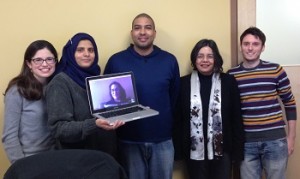Each year, 13,000 educational researchers come together for one of the most influential conferences in the field of education. This year, April 3-7 in Philadelphia, the AERA Annual Meeting offers a robust program of Presidential and AERA sessions; division and SIG paper/symposium, roundtable, and poster sessions; and professional development courses, as well as off-site visits and tours.
C&I is well represented at this year’s AERA annual meeting. Thirty-eight C&I faculty and graduate students will make 37 presentations including 2 symposia/panels. In addition, for 11 sessions, C&I faculty members and 1 C&I Ph.D. graduate will serve as session chair or discussant.

From Left to right: Beth Dillard Paltrineri, Sadaf Rauf Shier, Jehanne Beaton (on laptop), Justin Grinage, Nina Asher and Christopher Kolb
One of the symposia, “Agency and Implicatedness in Postcolonial, Global Contexts of Education: Interrogating Race, Language, Policy, and Practice,” will feature five unique presentations from C&I graduate students: Justin Grinage, Beth Dillard Paltrineri, Christopher Kolb, Sadaf Rauf Shier and Jehanne Beaton. Professor and Department Chair, Nina Asher will serve as symposium chair.
The session proposal emerged from a graduate seminar on “postcolonialism, globalization, and education” taught by Asher. This session will explore ways in which educational researchers, practitioners, and cultural workers might engage critical and postcolonial theoretical perspectives to reframe education as agentic and liberatory in global times. During a meeting to prepare for the conference, the graduate students talked about what they are most looking forward to at AERA this year.
“In thinking about what we might like to do at AERA, Nina had suggested some possible scholars working in the field who might be interested in serving as a discussant for the symposium,” said Christopher Kolb. “We came up with Dr. Cameron McCarthy at the University of Illinois at Urbana-Champaign who’s done a lot of work in multicultural education and postcolonial theory. We just sent him an email describing what our papers were about, how we were conceptualizing the symposium and what we wanted to talk about, and we invited him to serve as the discussant. Thankfully, he agreed!”
Sadaf Rauf Shier said, “For us, one of the big incentives is to present our papers in front of not just an audience, but also in front of a big scholar who is giving us direct feedback. That is a very important part.”
“You read papers and they are in dialogue with each other, right?” Beth Dillard Paltrineri said when talking about what she is most excited about for AERA. “All these articles are supposed to be. But, it makes it a lot more alive – the debate or the idea – when you see the actual people that wrote these papers in dialogue, face to face, in real time.”
Justin Grinage echoed this sentiment. “This is the largest education conference in the country. I want to try to meet as many people as possible; I’m excited to see people that I read up close and in person.”
“This feels like I’m stretching myself a little more to talk about my work in a much more formal structure,” said Jehanne Beaton through a laptop in a Google Hangout. “It’s really been at the heart of what I’ve been doing and I’m excited to talk with people who are more well-versed in postcolonial theory.”
“During a conference and the first couple days after a conference, I would say are the times when I’m most fired up about what I’m doing, because there is something about spending two, three or four days completely immersed in scholarship and talking about research and applications to classrooms and schools – it’s just that environment of constantly thinking and constantly questioning and being pushed by what other people are doing,” said Kolb. “It gets me excited about what I’m doing and what I could be doing.”



